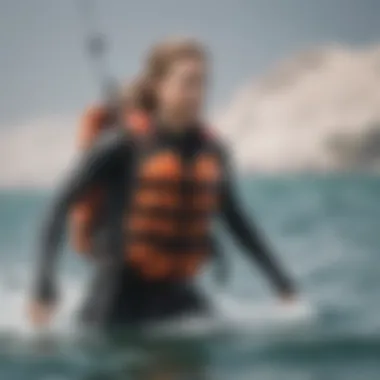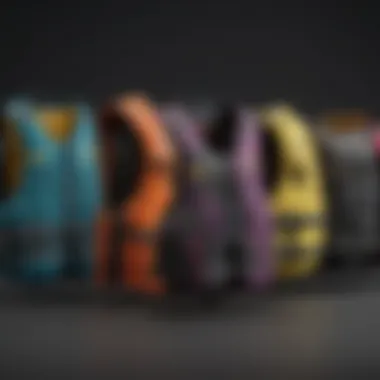The Kiteboarding Vest: Gear for Safety & Performance


Intro
Kiteboarding has emerged as a captivating blend of speed, skill, and agility. However, as exhilarating as it is, this sport comes with its risks. This is where the kiteboarding vest becomes pivotal. Designed for safety and performance, these vests provide more than just buoyancy. They are an essential piece of gear that enhances the kitesurfing experience.
In this article, we will explore the critical role of the kiteboarding vest. From understanding its features and benefits to navigating the various options available, kiteboarders can make informed decisions on their gear. Furthermore, we will delve into industry safety standards, maintenance guidelines, and recent innovations shaping the market. With insights tailored for both novices and experienced riders, this guide aims to be a comprehensive resource.
Prelude to Kiteboarding Vests
Kiteboarding is an exhilarating sport that combines elements of surfing and flying. Essential for anyone engaging in this activity is the kiteboarding vest. This piece of gear serves multiple purposes, primarily centered around safety and performance, as well as comfort. Understanding the significance of kiteboarding vests forms the foundation for a safe and enjoyable experience on the water.
Understanding Kiteboarding
Kiteboarding involves harnessing wind power with a large kite while riding on a board across water. This dynamic sport draws enthusiasts attracted to its thrilling nature and physical demands. Kiteboarding requires skill and coordination, but using the right gear is equally vital. The kiteboarding vest plays a crucial role in ensuring both safety and performance in this high-energy environment. The vest can provide buoyancy, impact protection, and helps maintain body temperature, especially during longer sessions.
The Role of Safety Gear
Safety gear in kiteboarding is not just an option; it is a necessity. Vests are specifically designed to protect against injuries that can happen during falls, crashes with the board, or even collisions with other kiteboarders. They also serve a dual purpose by providing flotation in case of emergency situations. In kiteboarding, where conditions can change rapidly, having reliable safety gear can make a significant difference.
Wearers must appreciate that safety is paramount when participating in such an inherently risky sport. A high-quality kiteboarding vest can deter serious injuries and provide a supportive structure for riders to better concentrate on their skills rather than their vulnerability.
Overall, the kiteboarding vest should be viewed not merely as additional equipment, but as an indispensable component necessary for achieving optimal performance and ensuring safety in this thrilling sport.
Types of Kiteboarding Vests
Understanding the different types of kiteboarding vests is crucial for riders who prioritize safety and performance while out on the water. Each type serves a unique purpose and offers specific benefits. Choosing the right vest can improve not only safety but also comfort, allowing for a more enjoyable kiteboarding experience.
Impact Vests
Impact vests are designed primarily to protect the torso from injuries during falls. They are equipped with padding to absorb impact and reduce the severity of a hit. This is especially important for kiteboarders who perform jumps and tricks, as falls can happen unexpectedly and can lead to serious injuries.
These vests typically have a sleek design and are made with lightweight materials. They allow for a full range of motion, which is essential for maneuvering while kiteboarding. The flexibility of impact vests means riders can perform movements without restrictions, contributing to overall performance.
Key considerations for impact vests:
- Padding Quality: Ensure the vest has adequate padding in areas prone to injury.
- Fit: A snug fit is essential to prevent the vest from shifting during use.
- Breathability: Look for materials that allow for air circulation to keep the rider cool.
Floatation Vests
Floatation vests, as the name suggests, offer buoyancy to assist individuals who may struggle in the water. These vests are crucial for newer kiteboarders or those who engage in high-risk maneuvers. They provide significant support during unexpected falls or during periods when riders might be separated from their board.
They come in various buoyancy levels, which should be selected according to personal requirements and competency. It's important to recognize that while these vests serve to keep the rider afloat, they can also impede movement compared to impact vests.
Points to evaluate when selecting floatation vests include:
- Buoyancy Rating: Ensure you choose a level that suits your needs ideally.
- Adjustment Features: Look for adjustable straps to customize the fit.
- Weight Distribution: Consider how the buoyancy affects body position in the water.
Hybrid Vests
Hybrid vests combine aspects of both impact and floatation vests, offering a balanced approach to safety gear. They feature padding to protect against impacts while also providing floatation assistance. This makes them versatile, catering to a wider range of riders from beginners to advanced.


These vests are somewhat heavier than pure impact vests but tend to be more suitable for riders who want both protection and buoyancy. They maintain a good balance, allowing users to feel secure without sacrificing too much agility.
When considering hybrid vests, keep in mind:
- General Use: Identify if the vest accommodates your general riding style and conditions.
- Material Choice: Look for durable and waterproof fabrics.
- Layering Compatibility: Ensure that it can be comfortably worn with other layers of gear if needed.
Understanding these distinctions between impact, floatation, and hybrid vests is essential for kiteboarders seeking to enhance their safety and performance on the water. By selecting the right type, riders can focus on the excitement of kiteboarding while minimizing potential risks.
Key Features of Kiteboarding Vests
The significance of understanding the key features of kiteboarding vests cannot be overstated. These attributes directly impact safety, comfort, and overall performance of riders who engage in kiteboarding activities. A vest is not just a support item; it plays a pivotal role in ensuring that the rider can navigate the elements with confidence and ease. When evaluating different kiteboarding vests, potential buyers should carefully consider several critical attributes that differentiate one vest from another.
Material and Construction
The materials used in kiteboarding vests add both functionality and durability. Most vests are crafted from high-quality neoprene or nylon, which provide flexibility and water resistance. These materials should not only keep the rider warm in colder conditions but also allow for significant freedom of movement to perform tricks and maneuvers.
The construction quality varies among brands, so it’s wise to examine stitching, seams, and overall finish. For instance, vests with blind stitch designs tend to minimize water entry and maximize comfort. Comfort comes from the way these materials are layered and shaped. Good material selection promotes both safety and performance.
Buoyancy Levels
Buoyancy is a fundamental aspect of safety when kiteboarding. Vests might offer varying levels of buoyancy, which is measured in Newtons or pounds of lift. A vest with insufficient buoyancy may struggle to keep the rider afloat in adverse situations. It is vital to select a vest that appropriately matches one’s body weight and riding style, whether it be for leisure cruising or high-adrenaline performances.
Enthusiasts should be aware that not all buoyancy is equally effective. The design must support the torso adequately while allowing the head to remain above water. It is advisable to consult product specifications and seek recommendations based on personal requirements.
Fit and Comfort
The fitting and comfort of a kiteboarding vest are paramount. An ill-fitting vest can restrict movement, create discomfort, and even lead to safety issues during operation. The vest should align closely with the body shape without being excessively tight. Adjustability features, such as side straps or buckles, allow customization for a snug yet comfortable fit.
Moreover, when trying on a vest, one should test its feel under various conditions, such as sitting and moving. Comfort extends beyond mere fit; it also involves assessing how the vest interacts with other gear, like harnesses. A seamless integration can enhance the overall kiteboarding experience.
Selecting the Right Kiteboarding Vest
Choosing the appropriate kiteboarding vest is critical for both safety and performance on the water. The correct vest can significantly impact your experience, ensuring comfort while providing essential buoyancy during high-speed maneuvers or crashes. It's not just about having the latest gear; it’s about selecting the right one that fits your specific needs and riding style.
Assessing Personal Needs
Before picking a vest, take a moment to evaluate your individual requirements. Consider the conditions in which you will be kiteboarding. For instance, are you a beginner or an experienced rider? Will you be riding in calm waters or areas with rough conditions? Understanding your skill level and the typical conditions will guide you in selecting a vest that offers the right balance of safety and performance.
- Skill Level: Beginners may prioritize more buoyancy and comfort. Experienced kiteboarders might look for something that allows for freedom of movement.
- Riding Style: Freestyle, wave riding, and racing may require different types of vests.
- Water Conditions: The type of water—flat, choppy, or waves—can impact your choice in buoyancy and protection levels.
Sizing Guidelines
Proper sizing is a vital aspect of selecting a kiteboarding vest. An ill-fitting vest can do more harm than good, resulting in discomfort and inadequate protection. Take the following steps to ensure an accurate fit:
- Measurement: Use a measuring tape to assess your chest size. Vests are often sized according to chest measurements.
- Consult Size Charts: Each brand has different size guidelines. Refer to the manufacturer’s sizing chart for the best match.
- Fit Preference: Some riders prefer a tighter fit for enhanced performance, while others may opt for a looser fit for comfort. It’s important to find which works best for you.
Trial and Testing
Once you have selected potential vests, trial and testing is essential before making a final decision. Try the vest in controlled conditions if possible. Here are some helpful tips for effective testing:


- Movement Check: Ensure the vest allows for a full range of motion when practicing kiteboarding maneuvers.
- Buoyancy Test: Test in shallow water to assess how the vest responds when floating. It should support you without feeling bulky.
- Comfort Assessment: Evaluate how the vest feels during a typical ride. Pay attention to any areas that may cause chafing or irritation during use.
By thoroughly assessing your personal needs, choosing the right size, and conducting proper trials, you can select a kiteboarding vest that enhances your safety and performance on the water.
Safety Standards and Regulations
Industry Standards
Safety standards in kiteboarding vests represent a critical aspect of ensuring user safety during the sport. These standards are established by recognized bodies and organizations, such as the International Kiteboarding Organization (IKO) and various safety equipment testing agencies. They define the criteria that kiteboarding vests must meet to be considered safe for use.
A primary standard to consider is the buoyancy rating. Vests are often tested to determine how much flotation they provide in water. This rating indicates a vest's effectiveness in keeping the user afloat, which is crucial in emergency situations. Other criteria may include impact resistance, the durability of materials, and the vest's ability to withstand various environmental conditions. By adhering to these standards, manufacturers help ensure that their products offer protection that meets or exceeds industry expectations.
Compliance Importance
Ensuring compliance with safety standards is important not just for manufacturers, but also for users. When riders select gear that is certified and compliant with these standards, they can have peace of mind knowing their vest has undergone rigorous testing. This testing aims to validate its performance under challenging conditions. Furthermore, compliance also plays a significant role in legal implications. In many regions, using non-compliant safety gear could lead to liabilities in case of accidents.
Moreover, consumers should be vigilant. Checking for labels and certifications when buying a vest is a simple yet effective way to ensure that high safety standards have been followed. By doing so, riders contribute to bettering the overall safety culture within the sport. Ignoring these standards might lead to regrets during critical moments on the water.
"Safety gear is only as good as its certification. Trust, but verify."
Innovations in Kiteboarding Vest Design
In today's fast-paced world of kiteboarding, innovations in vest design play a crucial role in enhancing both safety and performance. Kiteboarding vests are not merely protective gear; they are evolving pieces of technology that integrate new materials, advanced design concepts, and practical features aimed at improving the kiteboarding experience. Understanding these innovations is essential for both new and experienced riders who want to maximize their time on the water while ensuring their safety.
Technology Advancements
Recent advancements in technology have transformed kiteboarding vests significantly. Manufacturers now utilize high-tech materials that are lighter and more buoyant than those used in earlier designs. These materials provide better floatation without compromising mobility. For instance, vests made from neoprene or similar high-performance fabrics allow for flexibility while reducing drag in the water.
Moreover, innovations such as built-in hydration systems have begun to appear in some vests, enabling riders to stay hydrated without pausing their activity. The integration of quick-drying fabrics enhances comfort, as it minimizes the discomfort caused by prolonged exposure to water.
Another promising advancement comes from the field of design engineering, where 3D modeling is used to create vests that fit the human body more naturally. This approach results in improved ergonomics, providing a more snug fit that does not restrict movement. Vests are increasingly being designed to include reinforced areas for impact protection, which is critical in high-speed scenarios.
"The evolution in kiteboarding vest technology reflects the growing demands for performance and safety in extreme sports."
Sustainability and Materials
As environmental concerns gain traction across various industries, kiteboarding vest manufacturers have started to incorporate sustainable materials into their designs. Some vests now utilize recycled substances, reducing waste and environmental impact. These sustainable options assure wearers that their gear does not contribute negatively to the ecosystem.
The use of eco-friendly materials, such as organic cotton and recycled polyester, provides an alternative to traditional plastics. These materials not only offer durability and strength but are also less harmful to the environment.
Incorporating sustainable practices does not mean sacrificing quality. Many of these materials are tested to meet the rigorous safety standards required for extreme sports gear. Moreover, brands that prioritize sustainability often focus on creating vests that have improved longevity, which in turn reduces the need for frequent replacements and limits overall waste.
In summary, recent innovations in kiteboarding vest design focus on enhancing performance through technology advancements and addressing environmental sustainability. As riders, making informed choices about the gear we use not only maximizes our enjoyment on the water but also ensures we are contributing to a more sustainable future.
Caring for Your Kiteboarding Vest
Caring for your kiteboarding vest is crucial for maintaining its performance and longevity. As an essential item in kiteboarding, the vest not only provides safety but also comfort during your time on the water. Proper maintenance ensures that it will function effectively and protect you in various conditions. Investing effort in care can extend the life of your vest and enhance your overall kiteboarding experience.
Cleaning Procedures


Cleaning your kiteboarding vest regularly is vital. Saltwater, sand, and UV rays can degrade materials over time. To clean your vest, follow these steps:
- Rinse: After each session, rinse the vest in fresh water. This removes salt and sand that can cause wear.
- Gentle Detergent: If the vest is heavily soiled, use a mild detergent. Ensure it is safe for the materials used in your vest.
- Hand Wash: Avoid machine washing, as it may damage the vest. Instead, gently scrub using a soft cloth or sponge.
- Air Dry: Hang your vest in a shaded area. This prevents fading and deformation caused by direct sunlight.
Regular cleaning maximizes safety and performance. A clean vest means better buoyancy and less irritation during use.
Storage Recommendations
Proper storage of your kiteboarding vest is as important as cleaning. It keeps the vest in good shape for your next adventure. Here are a few storage tips:
- Dry Completely: Before storing, make sure your vest is completely dry. This prevents mold and unpleasant smells.
- Avoid Extreme Temperatures: Store the vest in a cool, dry place. Extreme heat can break down foam and other materials.
- Use a Hanger: Hanging the vest can prevent creases and maintain its shape.
- Keep Away from Sharp Objects: Ensure the storage area is clear of items that could puncture or damage the vest.
Following these care strategies can significantly enhance the life and functionality of your kiteboarding vest, ensuring you are always prepared for your next session.
Common Mistakes in Choosing a Kiteboarding Vest
Choosing the right kiteboarding vest is critical for both safety and performance. However, many kiteboarders, especially beginners or those looking to upgrade their gear, often make crucial mistakes in this process. Recognizing and avoiding these common pitfalls can significantly enhance your kiteboarding experience, ensuring that you not only perform at your best but also remain safe on the water. Below are some key mistakes to consider when selecting your vest.
Ignoring Fit
One of the most significant errors in selecting a kiteboarding vest is overlooking the fit. A vest that does not fit correctly can hinder your movement, affecting your balance and agility on the board. A well-fitted vest should snugly conform to your body without being too tight or restrictive. It is advisable to try on vests with typical movement postures, such as bending or twisting, to ensure comfort during your ride.
A poor fitting vest can also lead to discomfort and distraction. If the vest rides up or shifts during maneuvers, it can cause annoyance and take your focus off the sport. Prioritize fit by considering these factors:
- Size and Adjustment Options: Always check for vests that offer adjustable features, like side straps or zippers, to fine-tune the fit.
- Body Type: Be mindful of your body type and how different vests may fit. Styles may work better for specific body shapes.
- Layering Needs: Consider how you will layer clothing underneath. If you plan to wear a wetsuit or additional gear, ensure the vest accommodates this.
Overlooking Safety Certifications
Another critical mistake that kiteboarders often make is neglecting to check for safety certifications when purchasing a vest. Safety certifications from recognized standards ensure that the vest has been tested under certain conditions and meets minimum safety requirements. A vest that lacks proper certification might not offer adequate protection or buoyancy in emergency situations.
When assessing a kiteboarding vest, look for certifications such as:
- CE Marking: Indicates compliance with health, safety, and environmental protection standards.
- ISO Standards: Ensure the vest meets international safety parameters.
It is crucial to prioritize safety by confirming that any vest you consider has these certifications. Ignoring this aspect could lead you to buy a product that may not provide the support and protection you need in challenging waters.
"Always ensure your gear meets safety regulations to maximize your protection and performance on the water."
By avoiding these common mistakes—ignoring fit and overlooking certifications—you can make a more informed choice on your kiteboarding vest. Learning the importance of these factors will help you choose gear that enhances your performance and ensures your safety while enjoying the thrill of kiteboarding.
End
Kiteboarding vests play a crucial role in enhancing both safety and performance within this thrilling sport. The discussions throughout this article underscore the significant benefits of wearing a kiteboarding vest. These vests are not only designed to protect the wearer but also contribute to a more enjoyable experience on the water.
Recap of Importance
Several key elements highlight the importance of kiteboarding vests. First, the safety features embedded in these vests can prevent injuries during falls or crashes, which are common in kiteboarding. Vests such as impact and flotation varieties provide essential buoyancy and protection, ensuring that riders remain safe in various conditions. As kiteboarding can expose practitioners to unpredictable elements like waves and wind, the vest becomes an essential safeguard.
Furthermore, the advancement in materials and technologies used in the manufacturing of these vests has led to enhanced comfort and fit. When riders are comfortable, their focus on performance increases. The right kiteboarding vest should feel like a second skin, allowing for free movement while providing critical safety features. Understanding individual needs and preferences will result in better choices, ultimately improving the kiteboarding experience.
Final Thoughts
To conclude, the kiteboarding vest is not merely an accessory; it is a vital component of the sport. Before heading out on the water, it is essential to recognize the significance of choosing the right vest based on personal needs, style of riding, and safety standards. Being aware of common mistakes—such as ignoring fit and safety certifications—can help riders make informed decisions.
Investing in a quality kiteboarding vest is a commitment to safety, comfort, and an enhanced performance experience. Whether you are a beginner or seasoned athlete, this gear can make all the difference. Taking the time to understand your options, care for your equipment, and prioritize safety will lead to sustained enjoyment in the pursuit of kiteboarding.







